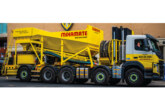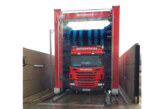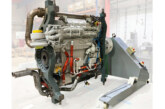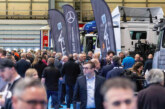
Bridgestone discusses the ever-changing world of tyre technology.
Bridgestone’s mission is to ‘Serve Society with Superior Quality’ and, with this in mind, the tyre designers and engineers use the latest technology, equipment, and the best quality materials to produce its premium Bridgestone tyre products. So, Bridgestone produces a wide range of products suitable for many of the daily requirements necessary for today’s busy fleet operators. Used in the correct application and with proper maintenance (e.g. correct tyre pressure, correct wheel position, turning on rim, regrooving, retreading, etc.), then the Bridgestone tyre will produce a good return in performance.
However, whether it’s a truck or bus tyre, each one of them will need to perform the four basic functions:
- To contain a volume of pressurised air to support the load
- To supplement the vehicle’s suspension (e.g. absorbing shocks from the road surface)
- To provide directional stability while changing or maintaining the direction of travel
- To transmit traction and braking forces to the road surface
And, without optimum air pressure, the three remaining functions will not deliver optimum tyre performance and it’s this item, tyre inflation pressure, which is often neglected. It is the air within the tyre which carries the load, not the tyre itself. Air to a tyre is what petrol/diesel is to an engine. It is estimated that over 80% of tyres which fail prematurely have been incorrectly inflated. Both over-inflated and underinflated tyres are potentially dangerous and reduce tyre life. The worst possible combination causing premature tyre failure is under-inflation and overloading. Always remember that it is the air within the tyre that supports the load; the tyre is just a vessel to contain the air – the air is the tyre’s ‘fuel’.
Optimum air pressure
In general, the larger the volume of air the higher the load carrying capacity of the tyre. Therefore, a bigger tyre will contain more air and therefore carry more weight. As vehicles are designed to carry a wide variety of goods, then the tyres must be designed to support the load at maximum condition. For this reason, tyres are available in a wide variety of sizes. In addition, with growing numbers of Euro VI vehicles and engines that have bigger exhaust systems, AdBlue, and additional vehicle safety features, then Bridgestone is applying extra load tyres on front axle (e.g. 315/70R22.5 has moved from 152/148M to 156/150L). Front axle loads have increased from 7,100kg to +8000kg front axle load.
Therefore, requiring higher inflation pressures (IP) than in the past (e.g. 125PSI or 8.6 Bar to 131PSI or 9 Bar). Bridgestone also find that many fleet operators or dealers have old compressors that cannot reach these optimum pressure recommendations. Remember that tyre inflation pressure can impact negatively on tyre life and fuel consumption, if pressures are not maintained. Therefore, good tyre IP husbandry can save a fleet thousands of pounds in both tyres and fuel. Therefore, always check the pressures when the tyres are cold and ideally first thing in the morning and check on a regular basis, ideally when the vehicles come in for their periodic servicing (note: Bridgestone recommends the fitting of High Pressure (HP) valve caps, or the use of Double-Check valves).
Finally, truck tyres may also be given a unique point on top of the standard Load Index (LI) & Speed Symbol (SS). This is a load/speed rating under increased load or speed. E.g. for a 385/65R22.5 160K the unique point may be 158L – the tyre can perform at increased speed, but decreasing the load. Important point to look out for, especially when fitting replacement steer tyres on Euro VI Vehicles, as the standard LI/SS may not be suitable for the vehicle plated front axle load.
Turning a tyre on its axle
The second most common maintenance failure is not turning a tyre on its rim or moving across an axle or on a different axle(s) where feasible. Because of operational factors (e.g. driver behaviour on braking & acceleration, topography of roads, loads carried, vehicle trailer heights, etc.) then there will be a tendency for mechanical wear to develop.
This is more common with high centre of gravity loads seen on higher trailers fitted with 60 Series tyres, where the vehicle movement has a rolling effect over the tyres. In addition to the effects of roundabouts, road conditions and drivers (e.g. harsh braking and acceleration).
With reference to roundabouts, Bridgestone sees tyre wear particularly on the left front tyre for the UK and Ireland markets, which take enormous dynamic loads when the vehicle goes around the roundabout. Pulling a trailer and axles that are not aligned correctly can also induce mechanical wear.
Therefore, deployment of tyre rotation is essential in order to maximise tyre life (e.g. rotation on rim, across axle, moving to another axle position, etc.). In addition, many modern trucks are fitted with engine brakes (ref: retarders/intarders) that interrupt the cycle of the drive axle, and in effect tries to put the drive tyres into reverse (note: whilst the vehicle is going forwards).
This can dramatically affect the tyres wear pattern and reduce wear life (ref: all of the engine braking is being done through the drive axle). Therefore, todays drive patterns are generally directional in nature, which are not so susceptible to the effects of mechanical wear, due to the angling of the tread blocks.
It is for the above reason why ‘heel and toe’ wear (ref: a type of mechanical wear) can be seen on deep treaded block-type drive tyres which have an open tread design (e.g. On/Off road tyres). Usually, the edge of the block that touches the road first (the heel) wears slowly, while the edge that touches it last (the toe) wears much faster. The result can be blocks that are worn at an angle.
Heel and toe wear is rarely a problem in itself, but can lead to more serious alternate block or “pumping” wear, and an increase in tyre generated noise – a good reason for taking corrective tyre rotation action. By reversing the direction of the tyres normal rotation, the forces involved are reversed, and the faster wear is transferred to the other side of the block.
The mechanical wear forces are still there, but the overall wear is more equalized. In addition, ensuring that the tyre pressures are correct and that the tyres are properly twinned will also help to reduce the effects of heel and toe.
As mentioned above, modern drive tyre patterns are directional in nature and therefore these tyres are designed to be initially fitted in the direction of the arrow symbol (note: direction arrow can be found on the tyre sidewall or high up in the shoulder area/edge of the tread blocks).

However, if heel and toe wear develops due to mechanical or operational conditions (ref: at approximately half worn stage) then the tyres can be turned without any real detriment to performance but it enables the tyre to wear more evenly. In summary, its good practice to turn tyres on their rim and, therefore, extend its service life (e.g. steer tyres to counter operational shoulder wear, and drive tyres to alleviate mechanical heel and toe wear). In addition to turning tyres on its rim, tyres should also be rotated around the vehicle. This is all good tyre husbandry!
Incorrect ‘tyre twinning’
The third most common maintenance failure is incorrect ‘tyre twinning’ on drive axles. The overall diameter of twin tyres must be as near equal as practically possible. A tyre with a diameter of more than 8mm difference to its twin will wear unevenly and more rapid.
It is also equally important for tyre pressures to be the same for both twin tyres. Unequal pressures will also lead to rapid and uneven wear. Also never mix new and retread within a twinned tyre arrangement, as again this can lead to uneven and rapid wear due to overall diameter and potential casing stiffness differences. It’s recommend that all tyres across an axle are of the same type (ref: either new or retread & not mixed).
The fourth most common maintenance failure is regrooving. Bridgestone truck tyres (ref: 17.5” and above) are generally suitable for regrooving. All Bridgestone tyres on which regrooving is permitted have on both sidewalls, in accordance with ECE regulation 54 the word ‘Regroovable’.
Regrooving should take place when the remaining tread depth is between 3.0 mm and 4.0 mm, and should be done by a qualified and trained tyre technician. At least 2.0 mm of base rubber should remain in the grooves following a recut. In some instances (e.g. harsh applications, etc.) it is often better to have a ‘No Recut’ policy, as this better preserves the casing value and saves time and money in not having to recut. Finally, it’s illegal to recut a tyre if you do not have an official regroove pattern, with depth and width to regroove from the tyre manufacturer, in addition to the words ‘Regroovable’ on the tyre sidewall.
Tyre choice
In addition to maintenance failures, tyre choice can also lead to early removal and disposal. All premium tyre manufacturers provide a comprehensive portfolio of tyre types for different types of operation (e.g. Highway, Regional, Mild On/Off, Severe On/Off, Urban, etc.). It’s extremely important when buying new vehicles or replacing tyres that you fit the correct tyre type for your operation. It’s like wearing shoes; you wouldn’t wear flipflops to climb a mountain. It’s the same for tyres and the operation to be applied. Within Bridgestone, it has multiple different products but I just wish to focus on a few:-
Highway: It must be remembered that in general, Low Rolling Resistance (LRR) tyres have a much reduced Original Tread Depth (OTD) in comparison to Standard tyres. Therefore, their potential mileage performance may be less, but generally the loss in any tyre mileage is compensated by positive savings made in fuel. Used in the correct application – long haul trunking/highway/continental runs – and with the correct pressures maintained, the Bridgestone Ecopia 002 tyres will return a competitive mileage performance with good mpg saving and a reduction in CO2 emissions. Generally not recommended for Regional and Urban applications where you have constant and regular stop/start operation.
In addition, for Low Rolling Resistance (LRR) tyres like Ecopia 002 to work 100% effectively, you need to ensure that you at least comply to three of the points highlighted below:
- You operate either a national or international service
- You measures fuel usage (note: a must have requirement)
- You have a driver training and monitoring system
- That your fleet operates ‘five star’ inflation pressure tyre husbandry
- That your fleet fits Low Rolling Resistance (LRR) on all axles including trailers
Regional: It must be remembered that in general, Regional (e.g. Bridgestone Versatility Duravis 002) tyres have a deeper original tread depth (OTD) in comparison to Highway tyres. Therefore, their potential mileage performance would be much higher. New Regional tyre designs also offer a degree of low RRC, so in some operations fuel benefits can also be observed (e.g. Duravis B/C for RRC). Generally used for national and local (urban) operations. Also suitable for heavy & light operations, including minimal on/off usage. Designed for longer & even wear life to minimise cost per kilometre.
On/Off Road: On/Off tyres also have a deeper original tread depth (OTD) to cope with an off road environment (e.g. Bridgestone M-Series 001). The deep tread design provides long tyre life and high traction on rough surfaces. Tyre pattern and tread compound is also designed for excellent resistance to cutting and chipping. Generally used for national and local on/off road operations. Suitable for waste, refuse & tipper type vehicles. Tyres have a deep and robust tread giving good traction on rough surfaces. However, wear life can be compromised when compared to a regional product due reduced pattern/block stiffness (ref: due to deeper OTD), in addition to on/off compound applied (ref: targeted for excellent resistance to cutting, tearing and chipping).

Unfortunately, there are often instances where the vehicle Original Equipment Manufacturer (OEM) fits a pattern that only suits their design needs (e.g. Low Rolling Resistance (LRR) tyres for Euro VI compliance and optimum fuel efficiency, plus low CO2 emissions). Also more often than not the end-user does not consider the tyres to be fitted when ordering new vehicles. Incorrect tyre selection leads to a poor performance return, either through a lower than expected mileage or from service damages, but in virtually all of these cases the end-user always considers the tyres to be at fault. So it’s imperative that when buying new vehicles or replacing tyres the end user selects the correct tyre for the application. So when replacing tyres they need to think about:
- What type of operation do I run?
- What type of goods do I carry?
- What are my average running distances?
- Is my key priority fuel saving or mileage?
- Do I monitor fuel vs mileage performance?
By considering the above and selecting the correct tyre product for the application, with proper maintenance (e.g. correct tyre pressure, correct wheel position, turning on rim, regrooving, retreading, etc.), then the tyre will produce a good return in performance.
Tyre storage
Finally, while it is important to consider tyre maintenance, husbandry, and tyre choice, tyre storage is also critical in order to deliver a good return in performance. Therefore, when storing tyres for prolonged periods never store the tyres in direct sunlight or near heat sources. Keep tyres away from motors and generators which yield ozone (note: aid accelerated tyre ageing). Keep tyres away from oils and chemicals. Prevent permanent deformation of tyres when stacking horizontally, so limit each stack to a maximum height of approx. 1.5m. Therefore, Bridgestone recommends the following methods: store unmounted tyres indoors in a dry location away from moisture. Before mounting a tyre on a rim or a wheel, be sure that the tyre’s inside surface and the inside surface of the rim are dry and clean. Keep compressed air sources for tyre inflation free of moisture.
It should be noted that tyres are complex vehicle products with many technological features and come in a wide variety of sizes to suit the design and operational needs of a vehicle/end user. In addition, tyres come in different patterns to suit the vehicle/trailer axle position and type of operation. Therefore, maintaining a robust tyre policy with regards to tyre selection, maintenance and husbandry will ensure maximum tyre performance and service life. A win, win for all!








